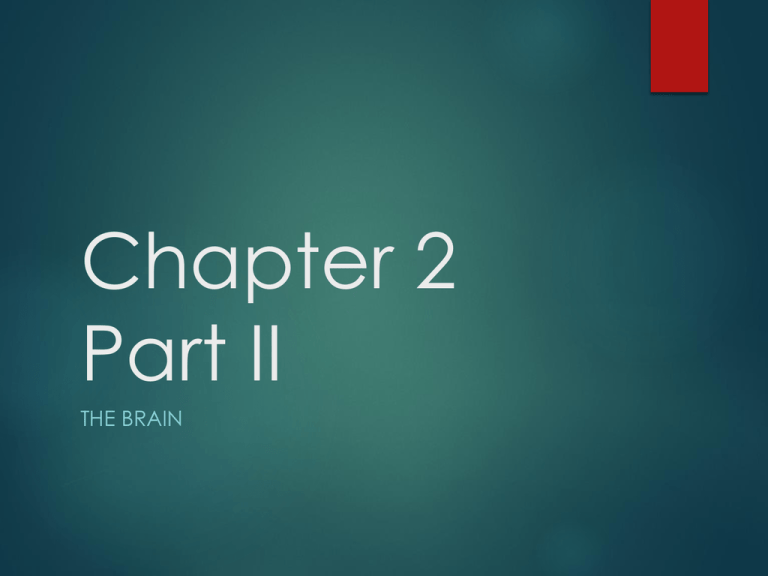The Brain
advertisement

Chapter 2 Part II THE BRAIN How We Study the Brain How We Study the Brain… I. Non Technological Methods: A. Prior to technology, BRAIN DAMAGE was the one way to understand what each part of the brain did. * “Tan” – Language Centers of Brain Phineas Gage http://www.learner.org/r esources/series142.html? pop=yes&pid=1592# How We Study the Brain B. Psycho-Surgery – Removal of brain tissue or structures leads to an understanding of those cells/structures. (tumors/elective) 1. Lesion: - Removal of specific cells/neurons 2. Lobotomy: - Severing of the connection between the limbic system and the prefrontal cortex. Used in 1940’s to “treat” people. Furthered understanding of these brain structures. No longer used for “treatment” because it didn’t work. How We Study the Brain II. With the help of technology A. Microelectrode Techniques: (Penfield/Delgado Motor/Sensory Cortex Maps) They detect impulses from AN ELECTRODE and follow it through the body to the brain or brain to body. B. Electroencephalagraph EEG Traces CHARGES produced by IONS by filtering out everything but the electrical wave created by an outside stimulus. C. Computerized Axial Tomography C/T or CAT SCAN Still-life TWO-DIMENSIONAL photo of the brain. Electrode Probing CT/CAT Scan EEG: electrical activity How We Study the Brain D. Magnetic Resonance Imaging (MRI) A person’s head is placed in a MAGNETIC FIELD where ATOMS are disoriented by brief PULSES . When atoms return to normal, they emit SIGNALS -- a computer generates images of the soft tissue from these signals. 1. fMRI (Functional MRI) Watch the video clip about brain imagining and write a brief description about how this works. MRI MRI: detailed pictures How We Study the Brain E. Positron Emission Tomography (PET SCAN) Our brains consume GLUCOSE (sugar) when active. An individual is INJECTED with a low dose of RADIOACTIVE sugar. The scanner then shows full COLOR of each area of the BRAIN that consumes the radioactive sugar by burning it. Actually picks up the HEAT rays emitted by the cells when they burn the glucose. PET scan: glucose burn PET Scan Overview of the Brain The brain is divided into three regions. A. The Hindbrain 1. Sub-Cortex (left hand): The “OLD BRAIN”, Hindbrain These structures are the earliest to EVOLVE according to evolutionary psychologists. The sub-cortex is made up of structures that control our BASIC needs such as INSTINCTS, EMOTIONS and INVOLUNTARY responses. B. The Midbrain C. The Forebrain 1. Cerebral Cortex(right hand): The “NEW BRAIN”, Cerebrum This is the upper, WRINKLED layer of the brain divided into two HEMISPHERES and four LOBES. The cerebrum is made up of structures that influence upper level functioning such as LOGIC, LANGUAGE, LONG-TERM MEMORY and ABSTRACT thought. Divisions of Brain Diagram 1 Overview of the Brain C. Matter: 1. White Myelinated neurons of CNS vs. 2. Gray Non-Myelinated neurons of CNS Overview of the Brain D. Fissures/Wrinkles 1. Longitudinal Separates hemispheres (L/R) 2. Central Separates frontal lobes from parietal lobes 3. Lateral Separates frontal and parietal lobes (top) from temporal lobes (bottom) Overview of the Brain E. Systems: 1. Nervous Neurons/Neurotransmitters ex. Frontal Lobes/Dopamine vs. 2. Endocrine Glands/Hormones ex. Adrenal Glands – Adrenaline Overview of the Brain Brain Structure Notes Song Break Brainstem! The Hindbrain/Sub-Cortex Structures A. Brain Stem(arm): Extension of the spinal cord into the BRAIN. Approximately 3 INCHES long. Controls AUTONOMIC functions such as: B. Medulla(tap/cross wrists): Nearest structure to the brain stem. 1.5 inches long. Controls BREATHING, heart rate, blood pressure, and, most importantly, this is the sensory and motor CROSS-over station. The Hindbrain/Sub-Cortex Structures C. Pons(yawn): This structure works with the PINEAL body to regulate SLEEP and WAKE cycles (circadian rhythm) by stimulating the release of SEROTONIN. It also communicates between the CEREBELLUM and the MOTOR CORTEX to help regulate balance and posture. D. Pineal Body(yawn): A part of the ENDOCRINE system. Releases the hormone MELOTONIN Works with the pons to regulate sleep/wake cycles. Controlled by LIGHT and DARK environments. Reflect: How do your own sleep habits relate to the information you’ve learned about the pons and pineal gland? Structures of the Hindbrain and Midbrain E. Midbrain: Several structures in the middle of the subcortex that are related to PAIN sensations. F. Thalamus - Thala MAIL amus (pass the mail): Sends FILTERED sensory information to the CEREBRAL cortex to be interpreted by these higher-level portions of the brain. Works as a SENSORY relay station. G. Reticular Formation(snap/tic): Also called the RETICULAR ACTIVATING SYSTEM. Filters incoming sensory information to send it to the THALAMUS Related to mental AROUSAL and the ability to focus attention. Structures of the Hindbrain and Midbrain H. Cerebellum(back of wrist): Also called the “LITTLE” brain because it is wrinkled like the fissures of the cerebral cortex. Located behind the BRAINSTEM under the OCCIPITAL lobe. Related to BALANCE, posture, and VOLUNTARY movement. I. Corpus Callosum: Large band of AXONS that communicate between HEMISPHERES of the cerebral cortex. Many INTERNEURONS that relay information back and forth. J. Pituitary: Another GLAND that secretes HORMONES rather than NEUROTRANSMITTERS. Known as the MASTER gland. This gland stimulates the other glands throughout the body to function when necessary. It also releases GROWTH hormone that regulates development early in life. The Sub Cortex/Hindbrain– Diagram 2 Hindbrain Structures – Diagram 3 Structures of the Hindbrain and Midbrain K. The Limbic System: THE EMOTIONAL Brain (heee heee, whaaaa!!!, grrrrr!!) Made up of three structures. Associated with basic emotions, basic drives, and basic memory formation. 1. Hippocampus: Center of MEMORY. Initial formations occur here for EPISODIC (personal) and SEMANTIC (factual) memories. Structures of the Hindbrain and Midbrain 2. Amygdala(pinky/thumb): Related to experiences of AGGRESSION and fear. Two basic emotions. Not the center of PROCESSING these emotions, though. FIGHT OR FLEEEEEE…. (by activating the hypothalamus) Reflect: What is your favorite brain part so far? 3. Hypothalamus: Right below the THALAMUS. Controls and regulates your basic DRIVES such as HUNGER, THIRST, and sexuality. It is considered to be your PLEASURE center. Forebrain Structures – Diagram 4 The Limbic System Electrode implanted in reward center http://www.learne r.org/resources/ser ies150.html?pop=y es&pid=1613 ..\BRAIN_SONG\BRAI NSNG.WAV The Cerebral Cortex The Cerebral Cortex The Cerebral Cortex: “NEW” Brain TWO Hemispheres FOUR Lobes 16 square feet FISSURES (wrinkles) (17 – 23 pieces of paper laid out flat) The Cerebral Cortex F(lower) P.O.T. Frontal Parietal Occipital Temporal OR F(reud’s) M(other) S(mokes) P.O.T Frontal (motor) (sensory) Parietal Occipital Temporal Frontal Lobes Behind forehead 1. Pre-frontal a. Personality, processing of emotions, abstract thought, logic, judgment 2. Motor Cortex (on frontal lobe) a. Speech production and muscle movement b. Axons cross over at the MEDULLA. c. Mapped for all muscle movement Parietal Lobes Behind Motor Cortex. Center/Top 1. Sensory Cortex (on parietal lobes) 2. Mapped for all skin sensations 3. Cross over at MEDULLA. Occipital Lobes Back of Cerebrum/Above cerebellum 1. VISUAL Cortex 2. Center of all visual processing The Cerebral Cortex Functional MRI scan shows the visual cortex activated as the subject looks at faces Temporal Lobes Behind temples 1. AUDITORY Cortex 2. Memory processing, facial recognition, understanding speech Association Areas 1. Areas within the brain that communicate using interneurons. 2. Full of NEURAL Networks, or series of connected neurons that connect at the synapse and grow in strength as you practice and/or learn. Association Areas More intelligent animals have increased “uncommitted” or association areas of the cortex Diagram 5 Language Centers 1. Broca’s Area: Broca/Boca Works with muscles, face and jaw to produce speech. Located in left, frontal lobe. If it’s damaged, we can’t SPEAK. 2. Wernicke’s Area Works to help us understand language. Located in left, temporal lobe. If it’s damaged, we can’t COMPREHEND. 3. Angular Gyrus: Responsible for turning written words into auditory form so that we can read language. Located between Wernicke’s and the Occipital Lobes in left hemisphere. If it’s damaged, we can’t READ. Language Centers – Diagram 5 Language Centers Brain activity when hearing, seeing, and speaking words Tan http://www.learner.org/resources/series142.html?pop=yes&pid=1574 – choose #6 The Cerebral Cortex Aphasia Broca’s Area (Disrupts speaking) impairment of language, usually caused by left hemisphere damage either to Broca’s area (impairing speaking) or to Wernicke’s area (impairing understanding) an area of the left frontal lobe that directs the muscle movements involved in speech Wernicke’s Area (Disrupts understanding) an area of the left temporal lobe involved in language comprehension and expression Sensory/Motor Right and Left Brain Which diagram (from the handout) “spoke” to you? Our Divided Brain Corpus callosum Corpus Callosum large band of neural fibers connects the two brain hemispheres carries messages between the hemispheres Split Brain a condition in which the two hemispheres of the brain are isolated by cutting the connecting fibers (mainly those of the corpus callosum) between them Roger Sperry Michael Gazzaniga http://www.youtu be.com/watch?v= aCv4K5aStdU The Endocrine System Endocrine System Chemical messengers are hormones, rather than neurotransmitters Messages travel through the bloodstream Diagnosis BRAIN!! WHAT PART(S) OF THE BRAIN ARE DAMAGED? DISCUSS AND EVALUATE AS A TEAM USING YOUR NOTES, KNOWLEDGE, AND SUPER DUPER ASSOCIATION AREAS. Mr. Livingston Mr. Livingston is a 39 year-old African-American male who has been brought into your neurology clinic by his wife. She has become increasingly alarmed regarding her husband’s health over the past four months. Upon completion of CT scans, it is determined that Mr. Livingston’s condition is the result of the presence of two tumors that have developed in his brain. Using this patient’s medical history below, determine where these two tumors are probably located. Mr. Livingston’s Symptoms Muscle weakness Vastly increased appetite (gained 25 lbs) Inappropriate body temp fluctuations Jerky movements Decreased sexual desire Poor balance when walking and standing Increased urination Inability to throw objects Inappropriate sleeping patterns Exaggerated efforts to coordinate movements when completing a task. Shooting Victim At 1:30 a.m. you (a trauma surgeon) are called for emergency surgery on a 17 year old Caucasian female that was shot in the head during a driveby shooting. After tedious surgery, the patient remarkably remains alive and doing reasonably well. The bullet traveled completely through the skull leaving a path of destroyed tissue behind. You have decided to speak with the parents about what noticeable changes will occur in their daughter due to the destruction of the neural tissue. Based on the information below, determine the approximate path the bullet traveled (i.e., what structures were damaged). Symptoms Limb numbness Inability to control movement in the left shoulder, arm, forearm, and hand. Slow, laborious, nonfluent speech Inability to sound out words Difficulty finding appropriate words to use Irrational anger Easily startled and irritated by loud noises Reacts fearfully to sudden movements or changes in her environment Norman Folger You are a pathologist in a large northwestern city. You are conducting the autopsy on an 83 year-old male who was found dead in his home with no obvious cause of death. During the autopsy you discover the individual suffered two strokes. Based on the functional information below provided by the next-of-kin, where were the areas damaged by the stroke? Norman’s Symptoms Failure to do certain, specific movements Massive overeating Disrupted circadian rhythms Increased susceptibility to stress Poor muscle tone Inability to adjust heart rate Inability to focus attention Unrestricted water loss in kidneys Inability to recognize faces Temperature fluctuations Memory disruption Hearing loss THE ANSWERS!!! 1. Cerebellum, Pons, Motor Cortex Hypothalamus 2. Primary Motor Cortex(right hemisphere), Brocas Area, Amygdala 3. Hypothalamus, Reticular Formation, Temporal Lobes








